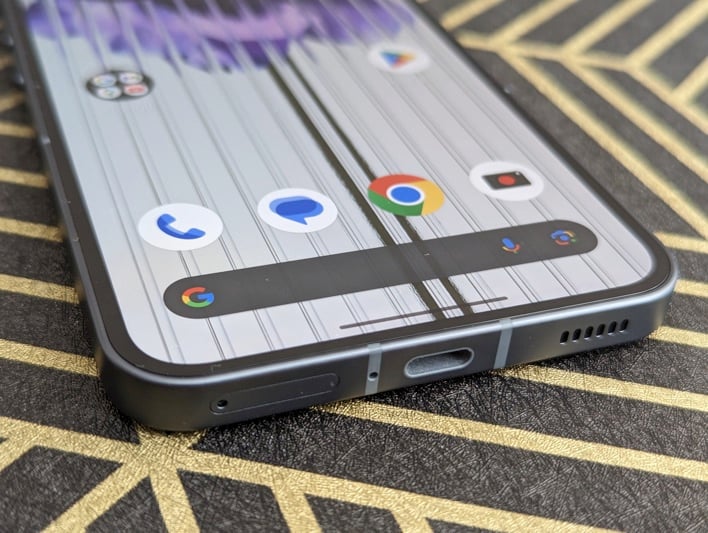Nothing Phone 2 Review: Lighting Up The Competition
Nothing Phone 2 Review: Audio Quality, Performance, And Battery Life
Nothing Phone (2) Audio, Data, and Call Reception
We tested Phone (2) on T-Mobile and Telus’ sub-6GHz 5G and 4G LTE
networks in San Francisco, Seattle, and Vancouver (Canada), and didn’t
have any issues with calls and data speeds. This phone also works fine on
AT&T and Verizon (though it isn’t officially certified for Verizon’s
5G network), but lacks mmWave 5G. Considering how small the mmWave
footprint is in the US, that’s really not a big deal.
On the audio front, Phone (2) features a great sounding pair of stereo speakers (earpiece plus bottom firing speaker). There’s no headphone jack here, but this handset supports both analog and digital audio devices over USB Type-C, so your wired listening experience is just a dongle away. And if you prefer going wireless, it offers aptX HD, LDAC, and LHDC codecs for high quality audio over Bluetooth.
On the audio front, Phone (2) features a great sounding pair of stereo speakers (earpiece plus bottom firing speaker). There’s no headphone jack here, but this handset supports both analog and digital audio devices over USB Type-C, so your wired listening experience is just a dongle away. And if you prefer going wireless, it offers aptX HD, LDAC, and LHDC codecs for high quality audio over Bluetooth.
Nothing Phone (2) Performance
Under the hood, Phone (2) features Qualcomm’s high-end 4nm Snapdragon8+ Gen 1 SoC, and delivers speedy performance to match. Obviously, it
handled our usual array of communication, productivity, and entertainment
apps without breaking a sweat. Three separate configurations are
available, with 8GB RAM (LPDDR5) and 128GB of storage (UFS 3.1), 12/256GB
(like our review unit), or 12/512GB – all without microSD support.
Subjective performance is one thing, but as you can see in our benchmarks below, Phone (2) is plenty quick, with test results generally matching other Snapdragon 8+ Gen 1-equipped handsets. Unfortunately, intense gaming and other sustained workloads don’t fare nearly as well. Phone (2) suffers from noticeable thermal throttling, dropping to 60.2% performance after 20 minutes in 3DMark’s Wild Life stress test.
Subjective performance is one thing, but as you can see in our benchmarks below, Phone (2) is plenty quick, with test results generally matching other Snapdragon 8+ Gen 1-equipped handsets. Unfortunately, intense gaming and other sustained workloads don’t fare nearly as well. Phone (2) suffers from noticeable thermal throttling, dropping to 60.2% performance after 20 minutes in 3DMark’s Wild Life stress test.
Nothing Phone (2) Geekbench Results
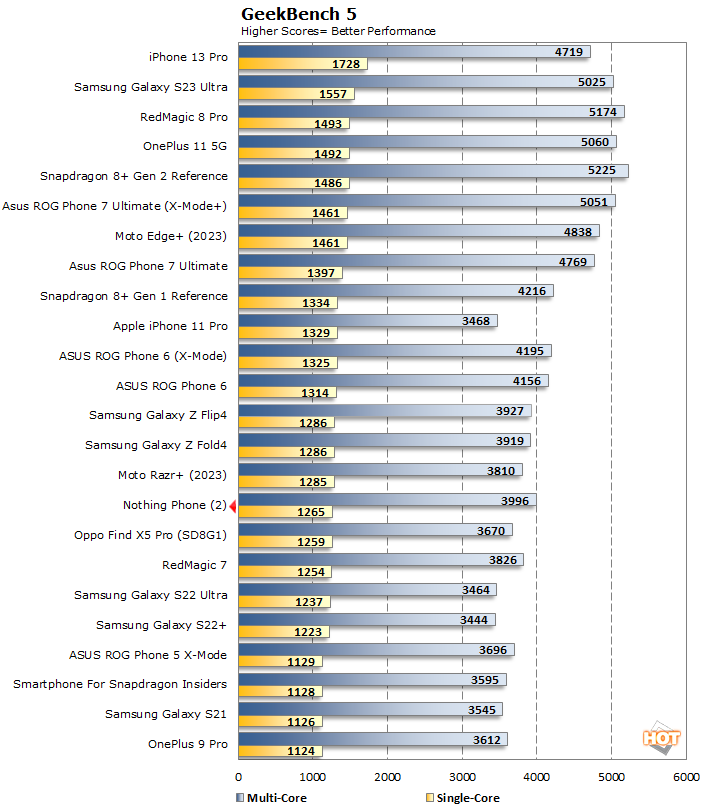
GeekBench is a purely synthetic benchmark and can be heavily targeted
for optimization. Regardless, the Snapdragon 8+ Gen 1 processor delivers a
notable improvement in single and multi-threaded performance over previous
generation Snapdragon
8
Gen 1-equipped Android flagships.
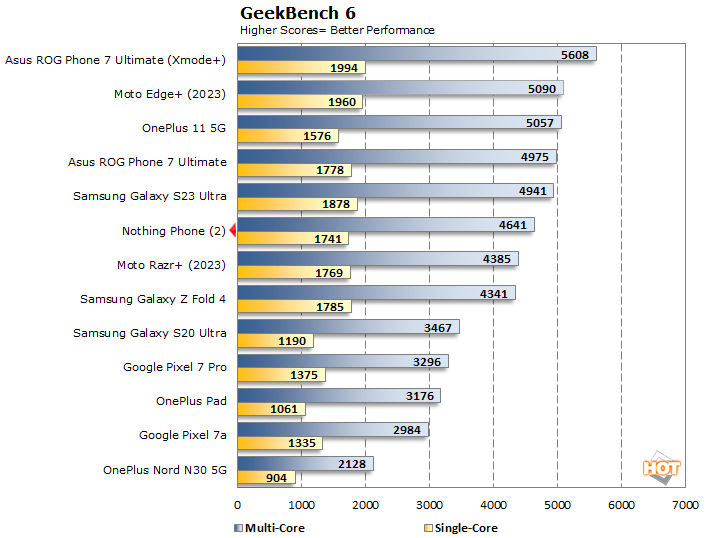
Recently, Geekbench was upgraded to version 6, which includes new ways
of testing multicore configurations and uses higher-resolution assets.
Since this benchmark is relatively new, we don't have as many data points, but
as you can see, Phone (2) performed quite well in this test.
Nothing Phone (2) PCMark For Android Benchmarks
Futuremark's PCMark for Android is an excellent suite of tests if you
want to benchmark a wide range of tasks on any handset -- things like
image and video editing, as well as lighter-duty, everyday workloads such
as email and web browsing. When you see the test running live, it's clear
the scripted application tests are carefully selected and tuned to make
use of the each mobile platform in a very controlled way...
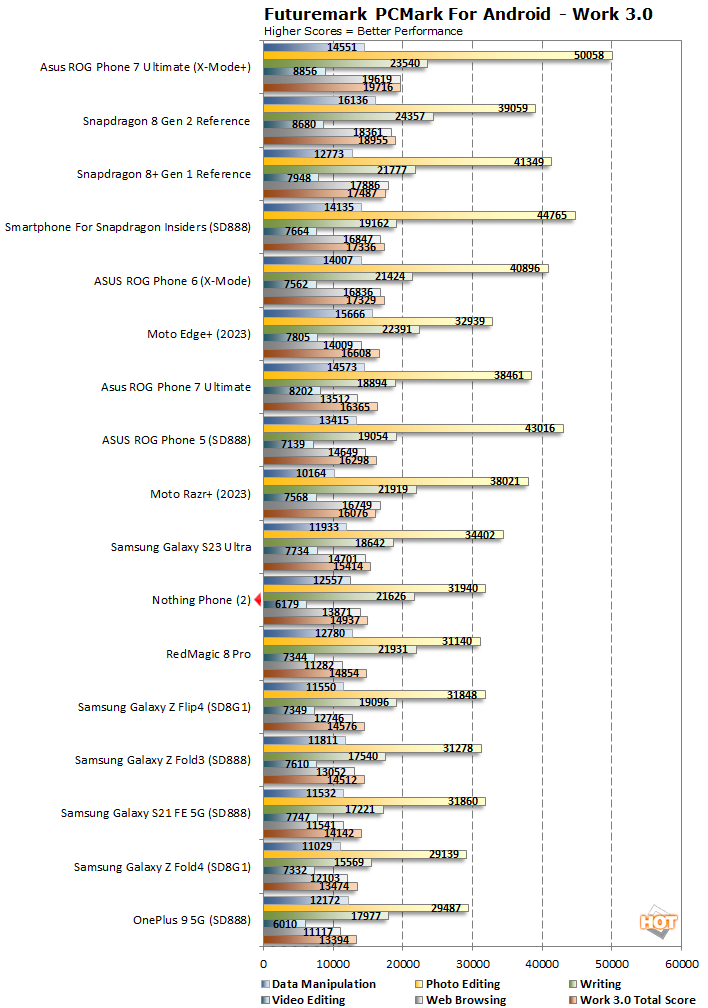
Here, Phone (2) actually shows similar performance to some current
Snapdragon 8 Gen 2-equipped devices, slotting just above the RedMagic
8 Pro.
Nothing Phone (2) AnTuTu 8 Benchmark Results
AnTuTu’s latest benchmark returns a number of metrics ranked with
somewhat nebulous scores, rather than frame rates or time to complete.
Here we're running the latest version of AnTuTu across multiple Android
devices. AnTuTu returns four top level performance results which are all
included here: CPU, RAM, 3D, UX (or User Experience), along with a total
score...


According to AnTuTu, Phone (2) offers similar performance
to other Snapdragon 8+ Gen 1 Android handsets, and slots just above the
OnePlus 10T in terms of its overall score.
However, in AITuTu, which is specifically an image recognition and classification benchmark for AI and machine learning workloads, we see a different picture. Here there are big gains for Snapdragon 8+ Gen 1 powered devices like Phone (2), putting it right alongside Samsung's Galaxy Z Flip4.
However, in AITuTu, which is specifically an image recognition and classification benchmark for AI and machine learning workloads, we see a different picture. Here there are big gains for Snapdragon 8+ Gen 1 powered devices like Phone (2), putting it right alongside Samsung's Galaxy Z Flip4.
3D Graphics And Gaming Benchmarks With The Nothing Phone (2)
Next we're checking how Phone (2) compares in GFXBench,
which has been one of the standard mobile graphics/gaming performance
benchmarks for years. To ensure that display refresh (v-sync) and
resolution aren't limiting factors, we're comparing off-screen test
results here. GFXBench tests OpenGL ES graphics workloads and we're
specifically testing OpenGL ES 2.0 and 3.0.
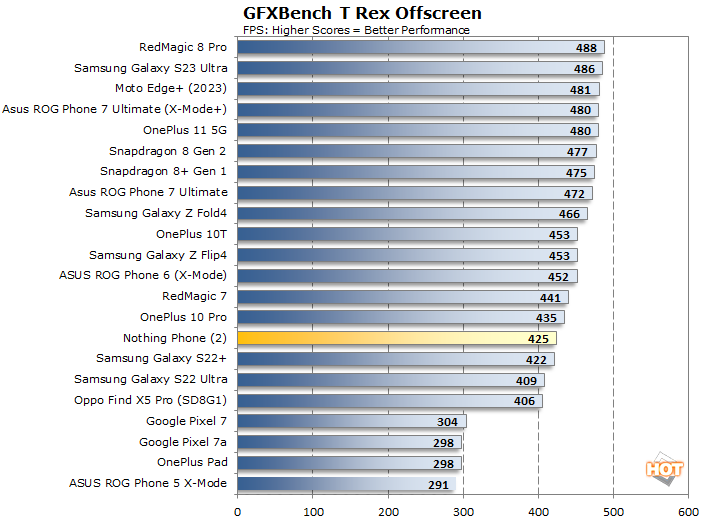

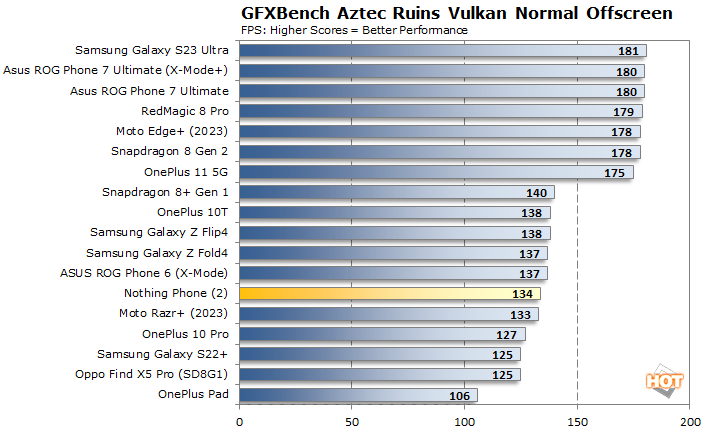
Based on other Snapdragon 8+ Gen 1-equipped devices we've reviewed, Phone (2) under-performed slightly in these tests, with results matching some other Snapdragon 8 Gen 1-based devices.
Futuremark's 3DMark Sling Shot is a newer benchmark module that's been added to the 3DMark mobile suite. Unlike previous gen 3DMark mobile tests, Sling Shot is a much more advanced OpenGL ES 3.1 and Metal API-based benchmark that employs more advanced rendering techniques, like volumetric lighting, particle illumination, multiple render targets, instanced rendering, uniform buffers and transform feedback.
Futuremark's 3DMark Sling Shot is a newer benchmark module that's been added to the 3DMark mobile suite. Unlike previous gen 3DMark mobile tests, Sling Shot is a much more advanced OpenGL ES 3.1 and Metal API-based benchmark that employs more advanced rendering techniques, like volumetric lighting, particle illumination, multiple render targets, instanced rendering, uniform buffers and transform feedback.

3DMark Sling Shot Extreme Benchmark
We're running this test in off-screen mode once again to remove
display resolution differences from the equation. This lets us compare
cross-platform results more reliably...
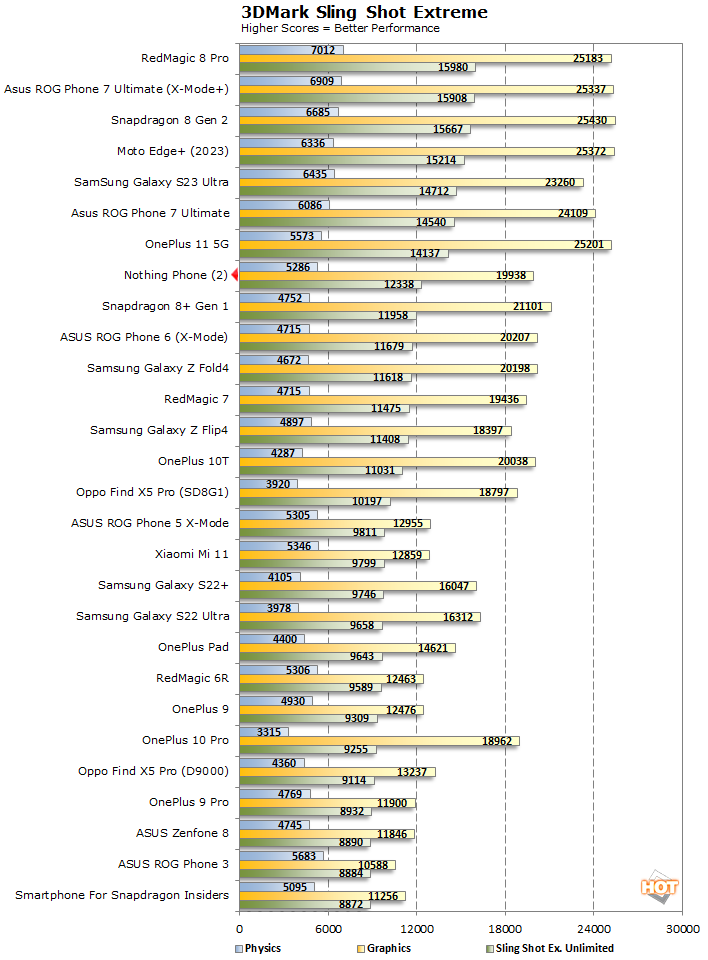
Here we only see a slight improvement to the overall score over
Snapdragon 8+ Gen-1-equipped flagships. Still, Phone (2)
performed well in this test, slotting right below the Snapdragon 8 Gen
2-equipped OnePlus 11 5G.
Nothing Phone (2) 3DMark Wild Life Benchmark Tests
3DMark Wild Life is the latest cross-platform test from UL. Its
primary purpose is to measure GPU performance across platforms, and two
distinct tests are available. The standard Wild Life test is designed to
give feedback on how a game performs over a short period of time. With
mobile games, people typically play in brief spurts when they find some
free time; be it on the bus, on the subway, or a quick battle royale
session over lunch break. The 3DMark Wild Life Stress Test, on the other
hand, shows how a device performs over a longer stretch of time, and
takes note of performance degradation that might crop up due to
increased heat levels and throttling.

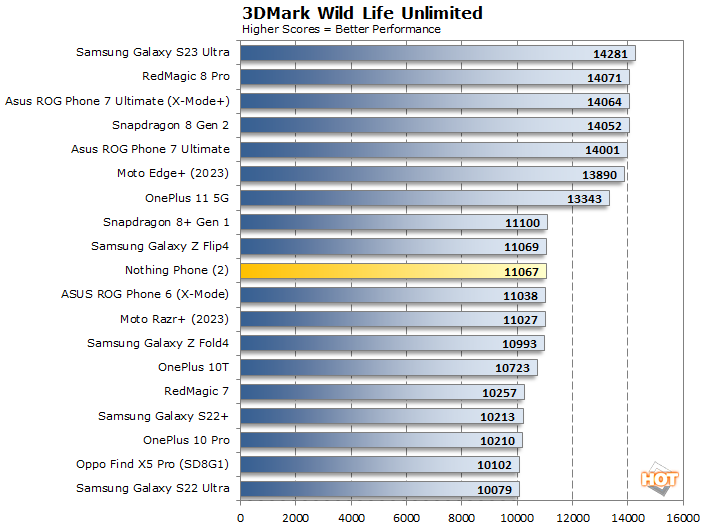
3DMark Wild Life is a significantly more taxing graphics benchmark
that employs cutting-edge mobile game engine technologies to deliver
impressive visuals -- as you can see in the screen shot above.
Here the Snapdragon 8+ Gen 1-powered Phone (2) matches similarly equipped devices, like Samsung's Galaxy Z Flip4..
Unfortunately, Phone (2) does exhibit significant
throttling, managing a stability score of just 60.2% in the Wild Life
Stress test.
Nothing Phone (2) Other Features and Battery Life
Other specs are what you’d expect for a modern flagship these days.
You’ll find sub-6GHz 5G on board, plus CAT 22 LTE, dual-band WiFi 6
(802.11ac), Bluetooth 5.3 (LE), NFC, and dual-band A-GPS/ GLONASS / BDS /
GALILEO / QZSS / NavIC positioning – plus the standard collection of
sensors. The optical in-display fingerprint sensor is fast and reliable,
and so is face unlock. In addition, haptics feel excellent.
Battery life is outstanding. Phone (2) only packs a 4700mAh battery, but it easily lasts a full day of heavy use on a charge. It scored a whopping 17 hours and 19 minutes in our PCMark Work 3.0 battery life test. This handset supports 45W wired fast charging (USB PPS) and 15W Qi-compatible wireless charging, plus 5W reverse wireless charging. While there’s no charging brick supplied in the box, Nothing includes a nice, partially transparent USB Type-C cable.
Next up: the software, pricing, and the review verdict...
Battery life is outstanding. Phone (2) only packs a 4700mAh battery, but it easily lasts a full day of heavy use on a charge. It scored a whopping 17 hours and 19 minutes in our PCMark Work 3.0 battery life test. This handset supports 45W wired fast charging (USB PPS) and 15W Qi-compatible wireless charging, plus 5W reverse wireless charging. While there’s no charging brick supplied in the box, Nothing includes a nice, partially transparent USB Type-C cable.
Next up: the software, pricing, and the review verdict...

